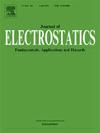体积电晕放电和表面介质屏障放电产生的离子风:流线体起什么作用?
IF 1.9
4区 工程技术
Q3 ENGINEERING, ELECTRICAL & ELECTRONIC
引用次数: 0
摘要
本研究比较了体积直流和交流电晕放电以及表面介质阻挡放电(DBD)产生的离子风。一方面,在高压针和接地板之间点燃的体积电晕放电情况下,我们的测量结果表明,离子风的速度在出现正击穿流线时会增加。另一方面,在表面交流 DBD 的情况下,出现流线时离子风速会降低。为什么会出现这种差异?答案并不简单,争论仍未结束。不过,其中一个答案是,在体积针对板放电中出现的流线会在电极间隙中留下大量正离子,这些离子在流线传播后会因电场而漂移。另一方面,在表面 DBD 的情况下,流线会在其尾部留下正离子,但其头部尤其会在停止传播的位置沉积正离子,即距离电极几毫米处(最多约 10-15 毫米)。这样,在电介质表面距离有源电极边缘几毫米处沉积的正空间电荷就起到了屏蔽外加高压所产生的电场的作用,从而阻止了残留在电介质表面靠近电极边缘的离子漂移。尽管如此,与这两种放电中发生的非常复杂的现象相比,特别是在流线形成和传播的时候,这种解释无疑是非常简单的。本文章由计算机程序翻译,如有差异,请以英文原文为准。
Ionic wind produced by volume corona discharges and surface dielectric barrier discharges: What role do streamers play?
The present study compares the ionic wind produced by volume DC and AC corona discharges, and by surface dielectric barrier discharges (DBD). On the one hand, in the case of a volume corona discharge ignited between a high-voltage needle and a grounded plate, our measurements highlight that the ionic wind velocity increases in the presence of positive breakdown streamers. On the other hand, in the case of a surface AC DBD, the ionic wind velocity decreases when streamers occur. Why such a difference? The answer is not easy and the debate remains open. However, one answer would be that the streamers occurring in a volume needle-to-plate discharge leave an abundance of positive ions in the inter-electrode space and that these ions drift because of the electric field, just after the streamer propagation. On the other hand, in the case of a surface DBD, the streamers can leave positive ions in their wake but their heads especially deposit positive ions at the location where they stop propagating, i.e. a few millimetres from the electrode (up to about 10–15 mm). Then this positive space charge deposited at a few millimetres from the active electrode edge on the dielectric surface acts as a screen against the electric field due to the applied high voltage, thus preventing the drift of the ions remaining on the surface of the dielectric, close to the electrode edge. Having said that, the reality is that this explanation is certainly very simplistic compared with the very complex phenomena taking place in these two discharges, particularly at the times when the streamers form and propagate.
求助全文
通过发布文献求助,成功后即可免费获取论文全文。
去求助
来源期刊

Journal of Electrostatics
工程技术-工程:电子与电气
CiteScore
4.00
自引率
11.10%
发文量
81
审稿时长
49 days
期刊介绍:
The Journal of Electrostatics is the leading forum for publishing research findings that advance knowledge in the field of electrostatics. We invite submissions in the following areas:
Electrostatic charge separation processes.
Electrostatic manipulation of particles, droplets, and biological cells.
Electrostatically driven or controlled fluid flow.
Electrostatics in the gas phase.
 求助内容:
求助内容: 应助结果提醒方式:
应助结果提醒方式:


